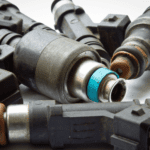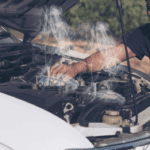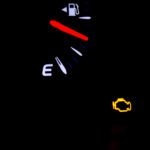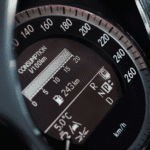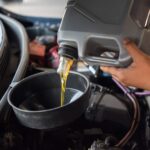Oil is not supposed to leak from anywhere! I’m sure you know that. So it can be a little concerning when you can visibly see oil dripping from the exhaust tailpipe.
Not to put a downer on it, but the only way oil can get into the exhaust is to go through the combustion process; yes, that’s right, the car is burning oil; more on that below in this article.
What Does Oil Coming Out of the Exhaust Mean?
Oil coming out of your car’s exhaust indicates a potential problem within the engine or from one of its supporting components. The exhaust does not usually have oil flowing through it, so oil found inside or leaking from it means that a component that carries or uses oil is leaking it into the engine to be combusted.
When oil is combusted, it leaves the engine through the exhaust system as thick blue smoke. Small oil particles also gather in the exhaust, where they will slowly drip out of the tailpipe. One thing to note is, unfortunately, oil in the catalytic converter or DPF will cause considerable irreversible damage to either, which is why it is important to find the cause quickly.
7 Reasons Oil Is Coming Out of the Exhaust
All of the seven reasons below have the same one thing in common, they are allowing oil into the combustion chamber (engine cylinder) where it is then combusted with air and fuel. When oil burns, it gives off a thick smoke, and oil particles collect and drip out of the exhaust. Now, oil never drips out of the exhaust in large amounts unless you have a bad problem. But the car will probably be undrivable due to other issues.
Failed piston rings
The piston rings do more than one job; they seal the piston into the cylinder but allow it to move up and down while also sealing off the combustion chamber from the crankcase where the oil is stored.
When a piston ring deteriorates, or a piston gets damaged, and the ring fails, oil can get into the combustion area. This oil is then burned along with the air-fuel mixture, producing visible smoke and emissions of oil particles through the exhaust system; the oil particles will build up and slowly drip from the tailpipe; with a failed piston ring you will notice the engine oil consumption increases while the engine performance and fuel efficiency drops.
The piston rings failing isn’t a particularly common thing; however, the reason for them failing is usually down to running an engine low on oil, causing overheating, contamination (debris or carbon build-up in the cylinder), or wear and tear. Replacing piston rings is not usually a job that can be carried on the drive at home with a basic tool set and requires engine removal and reboring of the cylinders, so it is best left to a mechanic to replace.
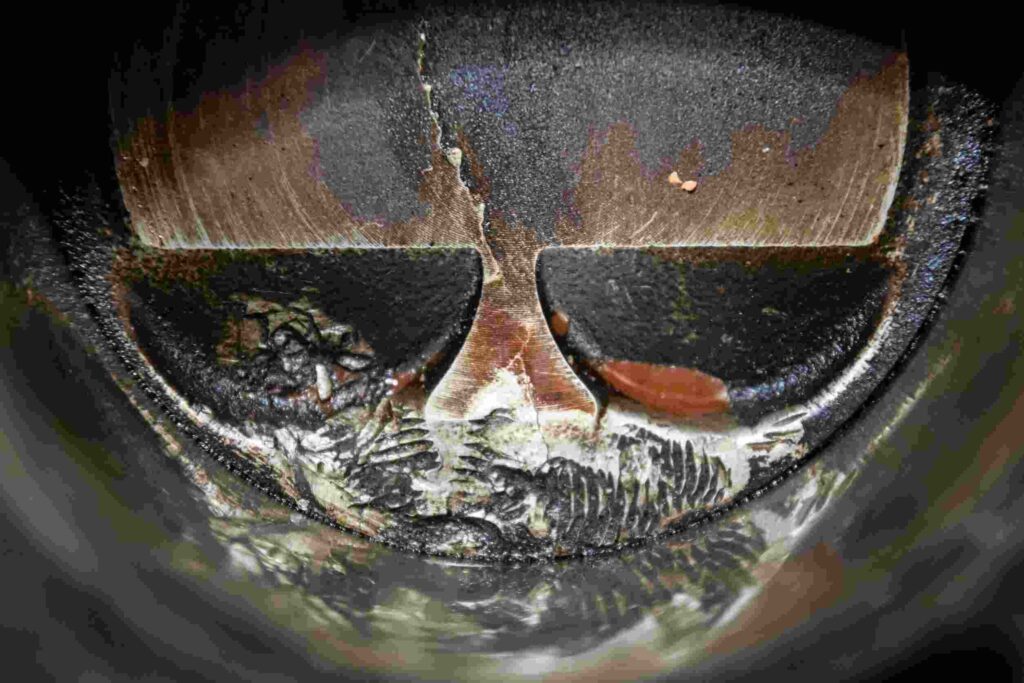
Leaking valve seals
At the top of each cylinder, intake valves open and close to allow the air-fuel mixture in. The mixture ignites, and the waste exhaust gases are released through an exhaust valve. Valve seals, also known as valve stem oil seals, positioned at the top of the valve guides, are responsible for stopping engine oil from being drawn into the combustion chamber during the intake stroke (when the intake valve is open).
When these seals deteriorate or become damaged, they lose their ability to seal off effectively. As a result, engine oil can seep past the damaged valve seals and enter the combustion chamber. Once inside, the oil gets burned during combustion, leading to visible exhaust smoke and emissions of oil particles through the exhaust system.
Valve seals usually fail due to age-related wear and tear, but it is also well known that they also fail from overusing fuel additives, which can cause damage to them. Unfortunately, replacing the valve seals involves removing the timing belt, the camshaft, and sometimes the whole cylinder head, which can go seriously wrong if not put back correctly. It is best not to carry this repair out at home on the driveway.
Leaking head gasket
The head gasket sits between the engine block and cylinder head, forming a seal to separate oil and coolant passages from mixing or entering the cylinder. When it fails or develops a leak, it allows engine oil to mix with coolant and force this mixture into the combustion chamber. As a result, oil gets burned in the combustion process, producing visible smoke that exits through the exhaust; oil particles gather in the exhaust and will visibly come out.
If the head gasket fails, the least of your worries will be oil dripping out of the exhaust, but it could be one of the first signs the head gasket may be gone. Other signs to look out for are oil in the coolant tank and the engine overheating.
Overfilled oil
When the oil level exceeds the manufacturer’s recommended capacity, it creates an imbalance in the oil. The excess oil gets ‘whipped up’ by the rotating crankshaft, creating excessive air bubbles in the oil, aerating it. This aerated oil loses its viscosity and lubricating properties, which can cause it to seep past the piston rings and valve seals, ultimately entering the combustion chamber.
Once it’s in the engine cylinder, it is combusted and forced out into the exhaust in clouds of smoke; oil particles will find their way out of the exhaust, where you will notice it dripping out the tail pipe.
Removing excess engine oil is straightforward with the right tools; however, if you get to this stage, a quick oil change may not be all that is needed.
Blown turbo seals
The turbocharger consists of two main parts, the compressor and turbine sides, separated by a central shaft. Seals are used to keep the oil lubricating the bearings and preventing it from mixing with the air on the compressor side. When the turbo seals fail, oil from the bearing housing can be drawn into the compressor side and eventually into the intake system, mixed with the air-fuel mixture and combusted. Oil will visibly come out of the exhaust as thick blue smoke and oil may spit out of the tailpipe.
Turbo seals fail for quite a number of reasons but the most common are:
- Low oil levels – Turbocharges rely on oil to keep the temperatures down and lubricate bearings. Extremely low oil levels will cause overheating and the pressure inside the turbo to exceed the seal’s rating, causing a failure.
- Overheating – Turbochargers operate at high temperatures and pressure. The extreme heat generated can lead to the degradation of seals over time.
- Oil quality – Poor-quality engine oil can accelerate seal wear and cause premature failure. It’s crucial to use the correct oil grade and change it regularly as the car manufacturer recommends.
- Oil contamination – Contaminants in the oil, such as dirt, debris, coolant, or water, can damage seals and accelerate failure.
- Over boosting – Running the engine at high levels of boost pressure, beyond the turbocharger’s design limits, can stress the turbocharger and cause failure.
- Turbocharger shaft play – Excessive shaft play can cause the compressor wheel to contact the housing, damaging the seals.
Turbos can be rebuilt and aren’t always just replaced; a replacement might be better suited to you. They aren’t particularly items to replace; you need to make sure they are secured using the correct clamps. The issue with changing turbos is their location in the engine bay; you might need to remove many components to get to it.
Malfunctioning pcv valve
The Positive Crankcase Ventilation, or PCV for short, is designed to release built-up pressure and harmful gases from the crankcase, such as blow-by gases and vaporized oil.
Common reasons a PCV fails are a blockage from old contaminated oil or a PCV being stuck open, which means air is drawn into the crankcase, increasing engine and oil pressure. The excess pressure can force engine oil past seals and gaskets, piston rings, and valve seals regardless of how the PCV fails. I’m sure you know by now, but this means the oil can be combusted and exits out through the exhaust.
Another specific symptom of a failed PVC is smoke coming from the oil cap, which is the excess engine pressure released.
Incorrect oil viscosity
Oil viscosity refers to its thickness or resistance to flow. If you use incorrect oil with a viscosity that is too thin (lower weight) for your engine, it may not provide adequate lubrication and sealing properties—using oil with a viscosity that is too thin (lower weight) for your engine. Remember, when hot oil gets even thinner, it can increase wear and tear on engine components and may result in oil getting past the piston rings or valve stem oil seals because it is too thin.
On the other hand, using oil with a viscosity that is too thick (higher weight) will have the opposite issue. Oil that doesn’t flow in an engine will increase internal engine pressure, Increasing oil leaks through seals and gaskets. This means oil can eventually find its way into the exhaust via the combustion process.
Should You Drive When Oil Is Leaking out of the Exhaust?
You should avoid driving if you see oil coming out of the exhaust; if you continue, the engine will fail. Let me explain, the problem with driving while oil is leaking out of the exhaust is number one, the increased chances of driving low on oil, which is dangerous, the engine will fail. Number two, a component within the motor that has failed caused the oil to get combusted, which means the car could break down at any time. Number three, oil is not supposed to leak out of the exhaust; it means oil is passing through the catalytic converter or DPF; they will fail, which is also not cheap to repair.
I should point out that not all of the causes of oil coming out of the exhaust are expensive to repair; using the wrong oil or PCV issue is relatively inexpensive. So please don’t think that the car will die; therefore, I should drive it until it does because it could be a quick, simple fix.
Final Thoughts
Although oil coming out of the exhaust, as either smoke or liquid, often means the engine is not in great shape, it doesn’t necessarily mean the end for it. Some of the issues such as a blocked PCV or incorrect oil, can be fixed easily and affordably. Unfortunately, a lot of the other problems are expensive and difficult to repair so you may need consult a mechanic.


